Expansions of Western Civilization
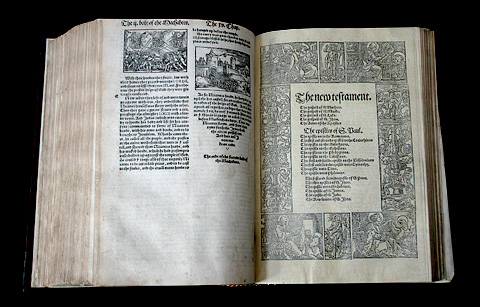
Coverdale Bible
Coverdale Bible
Miles Coverdale, 1488-1569
1535
First edition
Antwerp, Belgium
First published complete English Bible
Printed on paper and richly decorated in woodcut prints
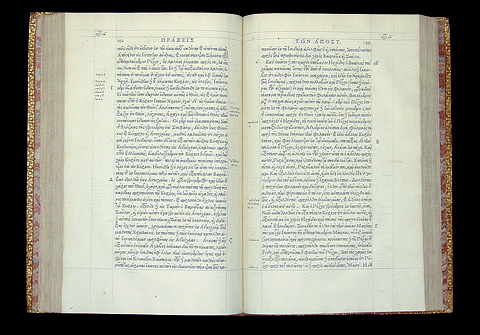
Robert Estienne's Greek New Testament
Estienne’s Greek New Testament
Robert Estienne (Stephanus), 1503-1569
1550
Third edition
Paris, France
This specific edition, known as the Editio Regia (Regal Edition), is popularly regarded as the Textus Receptus and is the edition to which Estienne first added the modern verse divisions. Though Estienne closely followed much of the wording in Erasmus’ later editions, this 1550 edition was soon regarded as the monument of Greek editions.
The 1550 Estienne edition displayed is still in its original binding and was once part of the Cardiff Castle Library in South Wales.
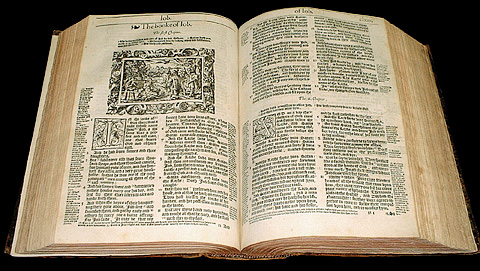
Bishops' Bible
Bishops’ Bible
1568
First edition
London, England
Set forth by Matthew Parker (1504-1575), the Archbishop of Canterbury under Elizabeth I, the Bishops’ Bible is a large folio that was intended to replace all the former English Bibles. It looks magnificent standing an inch taller than the Great Bible with large black letter type, 124 distinct woodcuts, four maps (three came directly from the Geneva Bible), a six page preface of the whole Bible, and a one page Preface to the New Testament. The paper used for the New Testament was actually a thicker paper because the printers expected it to be read more than the Old Testament.
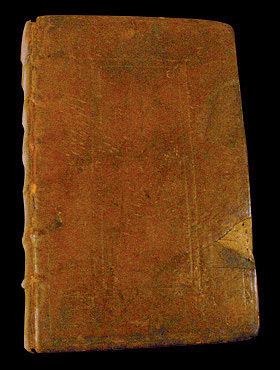
King James "He" Bible
King James “He” Bible
1611
First edition
London, England
Robert Barker, “The Printer to the King’s most excellent Majesty,” as the title page proclaims, printed the 1611 King James Bible. It is commonly recognized that from 1611 to 1614 there are two distinct series of edition in various sizes, which differ throughout in many minor points of typography, and are generally distinguished by the names ‘He’ Bibles and ‘She’ Bibles, from their respective readings of Ruth 3:15, “…he went into the city,” and, “…she went into the city.” The explanation for the difference is that the Bibles were printed in two separate offices, in order to facilitate rapid production. Biographers generally agree that the folio ‘He’ Bible of 1611 is the first impression of this version, though ‘She’ later became the accepted wording.
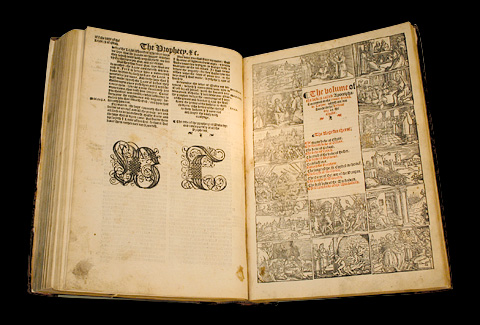
Matthew's Bible
Matthew’s Bible
John Rogers, 1500-1555
1537
First edition
Antwerp, Belgium
Printed on paper and richly decorated with woodcut prints
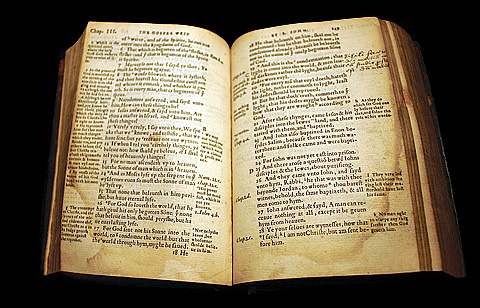
Geneva New Testament
Geneva New Testament
1557
Limited edition
Geneva, Switzerland
Attributed to William Whittingham (c.1524-1579), A. S. Herbert writes, “The text is based upon Tyndale’s, compared with the Great Bible, and largely influenced by Beza’s Latin translation.” This octavo New Testament is unique in that it is printed in Roman type and is the first English New Testament to have verse divisions, which are those Robert Estienne developed. In addition, words that were not in the Greek were printed in italics.
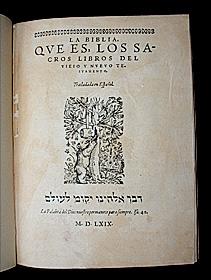
Cassiodoro de Reyna Bible
“Bear” Bible
Cassiodoro de Reyna, 1520-1594
1569
First edition
Basle, Switzerland
This is the first Spanish Bible translated from the original languages. It is printed on paper with decorative woodcut prints.

King James Bible "Wicked Bible"
King James Bible “Wicked Bible”
1631
London, England
The Wicked Bible contains an error in Exodus 20:14, where the Seventh Commandment reads, “Thou shalt commit adultery.” The printers are said to have been fined £300 for the offence, a huge amount at that time. Many believe, as P.M. Handover wrote in the Times (London) House Journal, that the error was deliberate on the part of a partisan of Norton to discredit the Barkers. There were one thousand Bibles in this edition, but the King ordered them suppressed, making the “Wicked Bible” very rare. This was the last edition printed by Robert Barker.
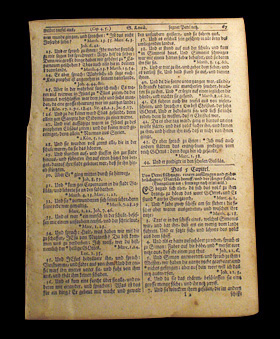
Sauer Bible Leaf
Sauer Bible Leaf
Christopher Sauer, 1695-1758
1743
Germantown, Pennsylvania
The most famous and ambitious product to come off Christopher Sauer’s press was a complete German Bible issued in the year 1743 in a large quarto edition. It was the first European language Bible published in America.
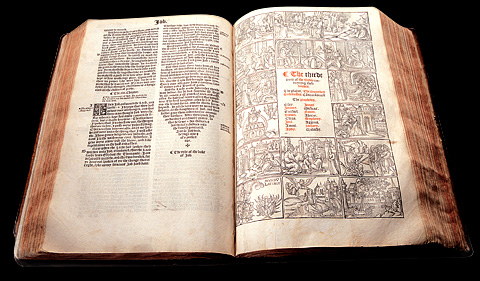
Great Bible
Great Bible
Also known as the English Pulpit Bible
1539
First edition
London, England
A collaboration of Biblical scholars including Miles Coverdale, who led an English team in revision of the Matthew’s Bible. Printed on paper and richly decorated with woodcut prints.
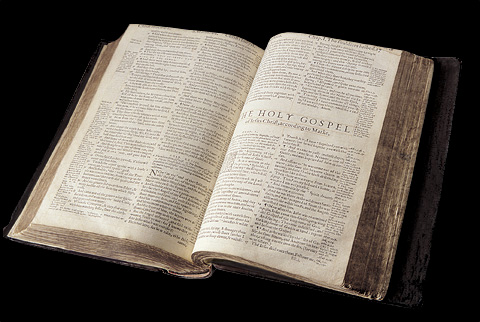
Geneva Bible
Geneva Bible
1560
First edition
Geneva, Switzerland
The Geneva Bible was printed on paper with woodcut illustrations and dedicated to Queen Mary’s half sister and successor to the English throne, Elizabeth I (1533-1603). It is often called the Pilgrim’s Bible, first arriving in America in 1607, to be followed by the Pilgrim’s themselves in 1620.
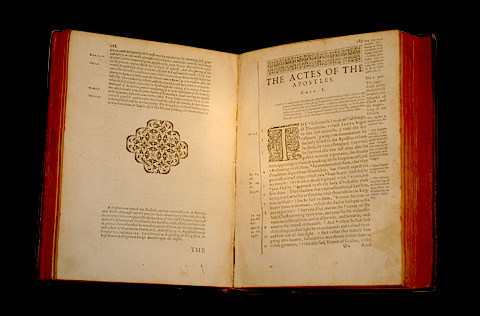
Rheims New Testament
Rheims New Testament
1582
First edition
Rheims, France
This Bible was translated from the Latin Vulgate Bible in the English vernacular for the Roman Church by Gregory Martin (1540-1582), an English Catholic scholar fleeing persecution from the Church of England, under the rule of Elizabeth I.
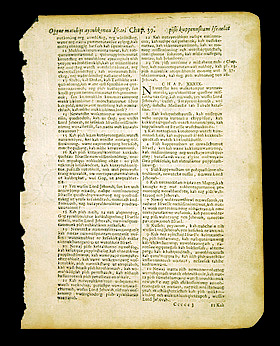
Eliot Indian Bible Leaf
Eliot Indian Bible Leaf
1663
Cambridge, Massachusetts
John Eliot, a religious leader in the New England Colonies, became so involved with the Indians that he worked for eight years to translate the Bible from English into Algonquin, a Native American Language. In 1663, the complete Eliot Indian Bible was printed. The Title page reads, “The Holy Bible: containing the Old Testament and the New / translated into the Algonquin Indian language and ordered to be printed by the commissioners of the United Colonies in New-England. Cambridge [Mass]: Printed by Samuel Green and Marmaduke Johnson, 1663.”
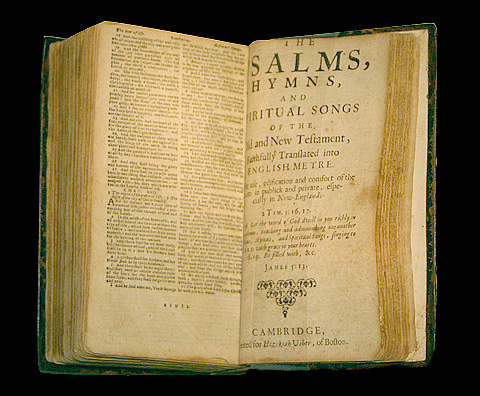
Bay Psalm Book
Bay Psalm Book
1648
Second edition
Cambridge, Massachusetts
The first edition of the Bay Psalm Book (a book of Psalms written to meter and rhyme) was printed in 1640. Two years prior the first printing press arrived in the colonies from London. It was the first book ever printed on American soil, twenty years after the Pilgrims landed on the Mayflower. Today there are eleven known surviving copies of the 1640 Bay Psalm Book.
Extremely rare, this second edition is one of only seven known copies—one of only three totally complete copies and the sole copy in private hands. Unlike the first edition, this second edition was bound together with a King James Bible that was shipped in from London because printing an English Bible in the early colonies was a violation of the king’s copyright laws.
